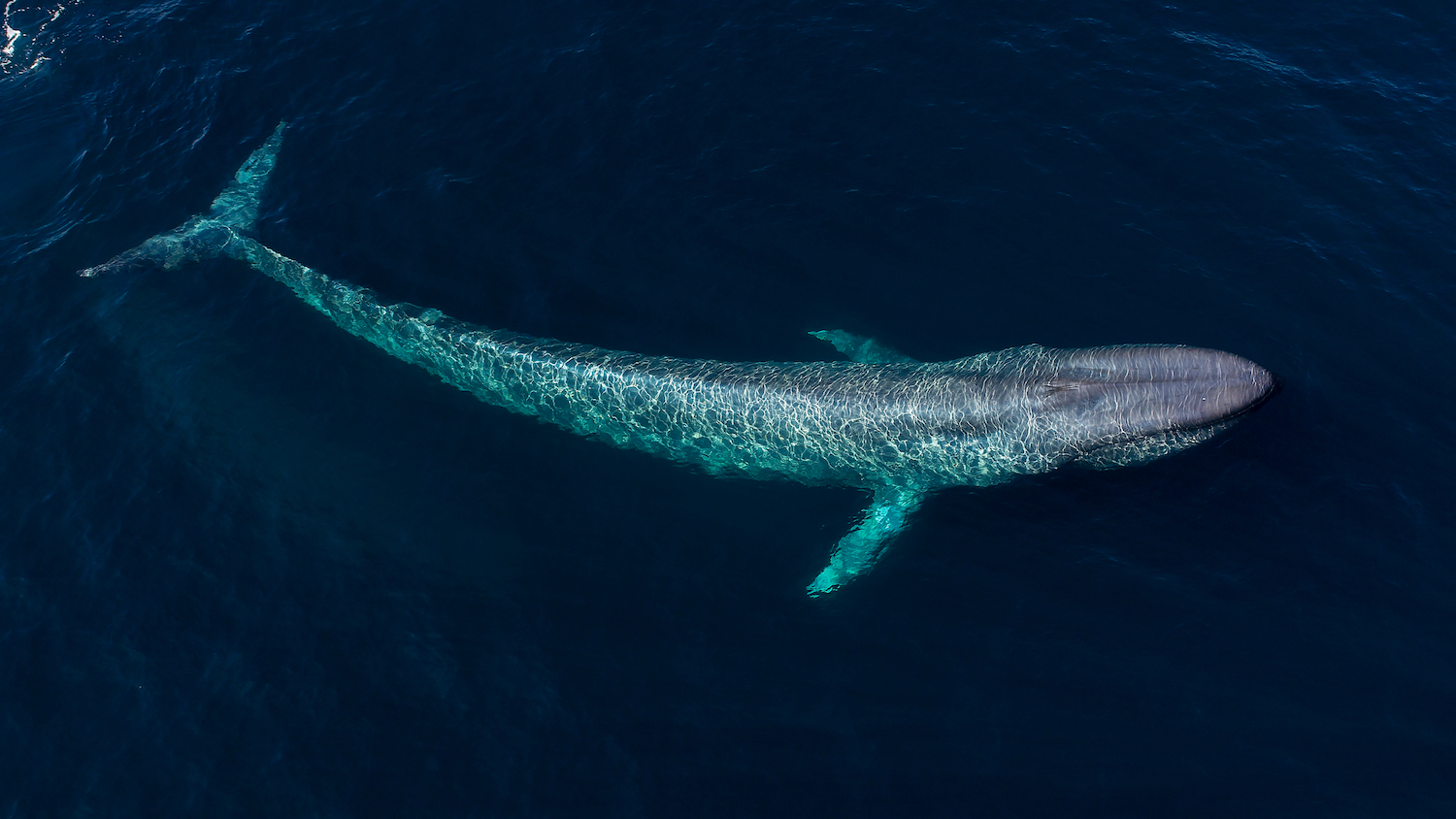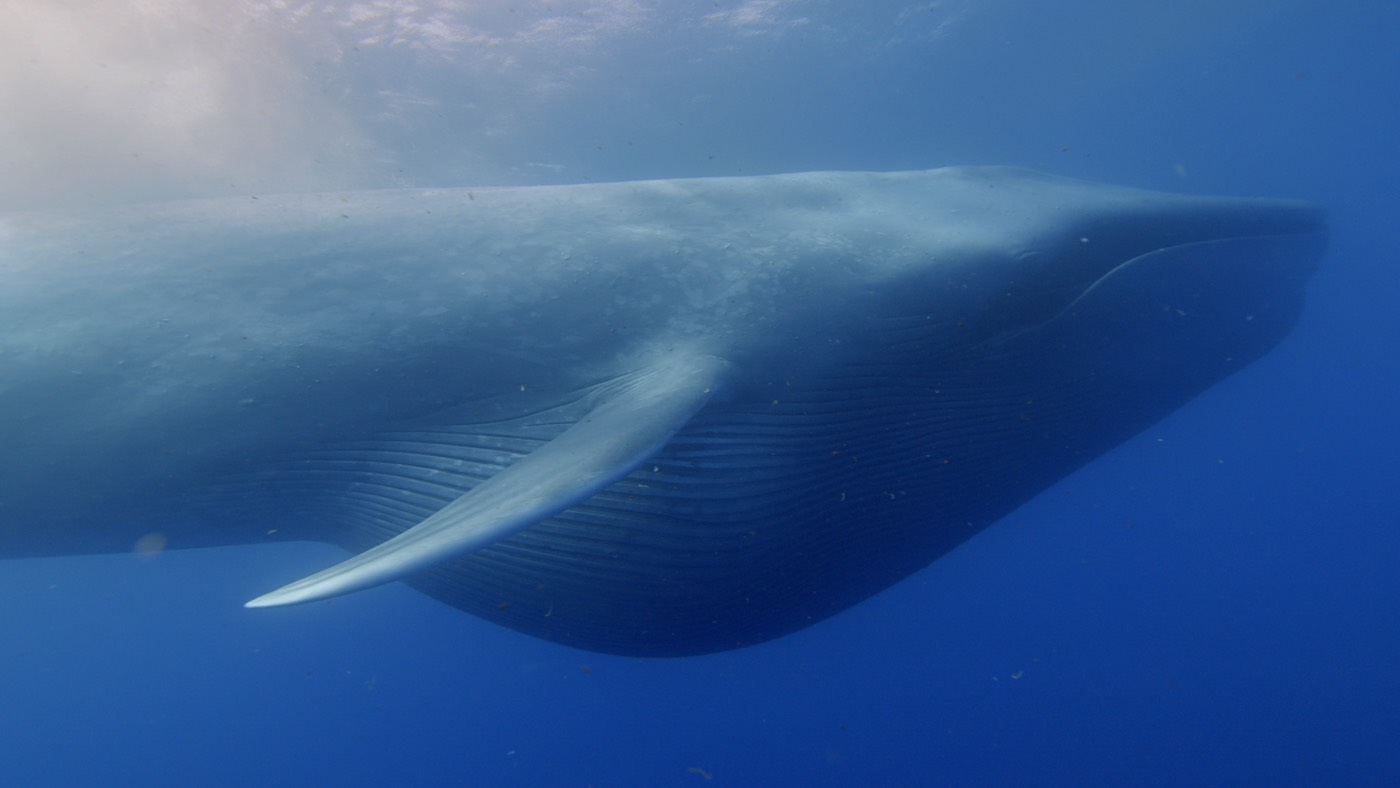Blue Whales: The Most Enormous Creatures on Earth
These baleen whales can reach up to 110 feet long.

The blue whale (Balaenoptera musculus) is the largest animal known to have existed in history. These enormous marine mammals have been known to reach up to 110 feet (34 meters) long, and the largest individuals likely weigh at least 150 tons (136 metric tons), according to the National Oceanic and Atmospheric Administration (NOAA) Fisheries. That's a little more than twice the length of a school bus and more than three times the weight of a semitrailer truck.
"You never cease to be impressed by the force and presence of these animals," said Richard Sears, a marine biologist and founder of the Mingan Island Cetacean Study, a nonprofit research organization that studies marine mammals. The full enormity of a blue whale may not be obvious from above the water's surface, but "when you're next to a blue whale underwater, it's magnificent," Sears said. "That's when your heart gets pumping."
Taxonomy and evolution
Blue whales belong to a group of whales called rorquals, which are baleen whales with folds or grooves in their skin that allow their mouths to expand to swallow larger volumes of water when feeding. Many scientists describe blue whales as belonging to one of three subspecies, with groups found in the Northern Hemisphere and the Antarctic, and a third, the pygmy blue whales (B. musculus brevicauda), in the Indian and Southwest Pacific oceans. Pygmy blue whales are smaller whales, but they may still grow to 79 feet (24 m) in length.
The distant ancestors of blue whales had legs and walked on land, but ventured into the water to find food. Over many generations, these creatures developed adaptations suitable for living in water full time, such as fins, blubber and blowholes. Although the fossil record is murky, research suggests that some of these animals lost their teeth and fed by sucking their prey into their mouths. These ancient, toothless whales are thought to have eventually developed baleen — brush-like plates with small gaps — to filter food out of the water they were sucking in.
Research published in 2017 revealed that blue whales likely began growing to such tremendous size only relatively recently, from an evolutionary standpoint — perhaps in just the past 3 million years.
Blue whales have been successful in reaching their humongous size because their water environment supports most of their mass compared to animals on land, and they've adapted to feed so efficiently on krill, Sears said.
Related: Whale album: Giants of the deep
Diet and habitat
Blue whales are found in oceans around the globe. Scientists keep track of populations in the North Pacific and Atlantic Oceans, as well as whales throughout the Southern Hemisphere.
The whales migrate long distances to find food in cold waters and rear calves in warmer areas during the coldest few months of the year. These trips extend from the tropics to the polar circles and cover thousands of miles.
Some whales have been spotted returning to the same locations year after year, but not always. Searching for whales by boat has its limitations, Sears said, so it often isn't clear to researchers if the "missing" whales just went somewhere else that year, or simply weren't seen by whale spotters.
Blue whales almost exclusively eat krill — small, shrimp-like creatures. The whales seek out large concentrations of their tiny prey, which they engulf in a large amount of water, sometimes spinning about as they do it. The water in one of those massive gulps weighs as much as the whale itself, Robert Shadwick, an animal biomechanics researcher at the University of British Columbia, previously told Live Science.
The whales push the water back out across their baleen filter, which catches the krill. Unlike toothed whales, blue whales lack teeth and instead have baleen, which are thin, semirigid plates that grow down from the top of the whale's mouth. The plates are lined up closely to one another and are made of a protein called keratin — the same protein that builds fingernails and hair. The amount of krill a blue whale captures in one gulp of water may provide nearly half a million calories of energy.

Life cycle
Scientists estimate that blue whales may live as long as 80 to 90 years. Sears has been tracking blue whales in the North Atlantic Ocean for over 40 years, and he continues to see some of the same individuals that he saw when he first started.
One of the reasons blue whales are able to live so long is their near-lack of predators. Orcas (Orcinus orca) are known to hunt and kill blue whales, according to three documented events witnessed off the Australian coast, a 2022 study published in the journal Marine Mammal Science found. But these three blue whales were on the smaller side, between 39 feet (12 m) and 72 feet (22 m) long. Most adult whales are so large that even the most vicious ocean predators steer clear. Humans pose the biggest threat to a blue whale's survival.
Blue whales can communicate over long distances with extremely loud, low-pitched calls that are below the range of human hearing. Scientists are still learning about the context for these calls and mating behavior.
Blue whales appear to reach sexual maturity somewhere around 9 years old, but researchers and whale trackers have been unable to determine if there are specific breeding-ground regions for blue whales.
What scientists do know, however, is that mother blue whales usually give birth to single calves, which are 20 to 23 feet (6 to 7 m) long, and weigh up to 6,000 pounds (2,700 kilograms). Calves nurse for six to eight months and may stay with their mothers until they are around 2 to 3 years old.
Conservation status
The World Wildlife Fund lists blue whales as endangered. Commercial whaling is no longer the major threat it once was, but climate change, pollution, human-made noise and shipping traffic are still concerns. Nonetheless, according to the International Union for Conservation of Nature and Natural Resources (IUCN), the global population of blue whales is increasing.
Sears estimates there may be anywhere from 10,000 to 18,000 blue whales worldwide. It's difficult for experts to determine a more exact population size because blue whales traverse such vast portions of the ocean, which makes them tough to track, Sears said. "We don't really have a handle on it."
And although blue whales are gigantic creatures, they're still really good at hiding from humans. The whales can frequently hold their breath for 20 minutes at a time and travel long distances in that time, which makes it difficult to follow them, even once they've been spotted, Sears said. "The study areas we give ourselves can already be pretty broad in terms of humans, but in the scale of blue whales, it's a joke," he said.
Sears estimates that researchers may glimpse only 5% of the blue whale's life when they come close enough for observation. The remaining decades of a blue whale's life may become easier to document with technology like drones and improved satellite tags. It may take two or three generations of biologists, said Sears, before there is a "comfortable" understanding of blue whale behavior and social interactions.
Further reading:
- Watch blue whales lunge feeding in this video from National Geographic.
- Check out key facts about blue whales, according to the World Wildlife Fund for Nature.
- Read more about blue whales and hear what they sound like, from The Marine Mammal Center.
Originally published on Live Science.
Sign up for the Live Science daily newsletter now
Get the world’s most fascinating discoveries delivered straight to your inbox.










